The Ultimate Homemade Mongolian Beef and Broccoli: A Lighter, Flavor-Packed Takeout Favorite
Experience the vibrant flavors of a beloved Asian takeout classic right in your own kitchen with this incredible Mongolian Beef and Broccoli recipe. This dish is a harmonious blend of tender, melt-in-your-mouth beef, crisp-tender broccoli florets, and a luscious, glossy sauce that boasts a perfect balance of sweet, savory, and umami. Unlike many traditional takeout versions that often rely on deep-frying and excessive oil, our recipe focuses on a healthier, lighter approach without compromising on the irresistible texture or the depth of flavor you crave.
We’ve perfected this recipe to give you an abundance of that rich, sticky sauce, making it absolutely ideal for generously drizzling over a bed of fluffy steamed rice, comforting noodles, or even additional stir-fried vegetables. The inclusion of vibrant, crisp broccoli not only adds a delightful crunch and fresh counterpoint to the rich beef but also boosts the nutritional value of your meal. This isn’t just another beef and broccoli recipe; it’s a fresh, flavorful, and healthier twist on a classic that’s guaranteed to satisfy your cravings and become a regular in your weeknight dinner rotation. Get ready for a better-for-you version that tastes even better than your favorite restaurant dish!

Why Our Mongolian Beef and Broccoli Recipe Stands Out
This Mongolian Beef and Broccoli recipe isn’t just good; it’s designed for success in your home kitchen. It works so well because it harmonizes simplicity with bold, authentic flavors, all while being significantly lighter than your typical greasy takeout. The secret to the beef’s incredible tenderness lies in our specialized marinating technique, which allows the meat to become wonderfully soft and juicy without the need for deep frying. This means less mess, fewer calories, and a more enjoyable cooking experience.
The addition of crisp broccoli florets isn’t merely for color; it’s a crucial element that brings a fresh, earthy bite, cutting through the richness of the beef and sauce. This creates a balanced and incredibly satisfying dish that feels both indulgent and wholesome. What truly makes this Mongolian beef recipe shine is its signature sauce—a perfectly crafted, rich, and glossy blend that captures the essence of sweet, salty, and savory notes. It’s thick enough to cling to every single piece of beef and broccoli, ensuring every bite is packed with flavor. We’ve even included a special twist for extra depth and, importantly, plenty of sauce to ensure you can generously coat your rice, noodles, or whatever side you choose. This recipe delivers everything you could possibly want in a classic beef and broccoli stir-fry, elevated to a new level of homemade deliciousness.
Key Ingredients for Authentic Mongolian Beef and Broccoli Flavor
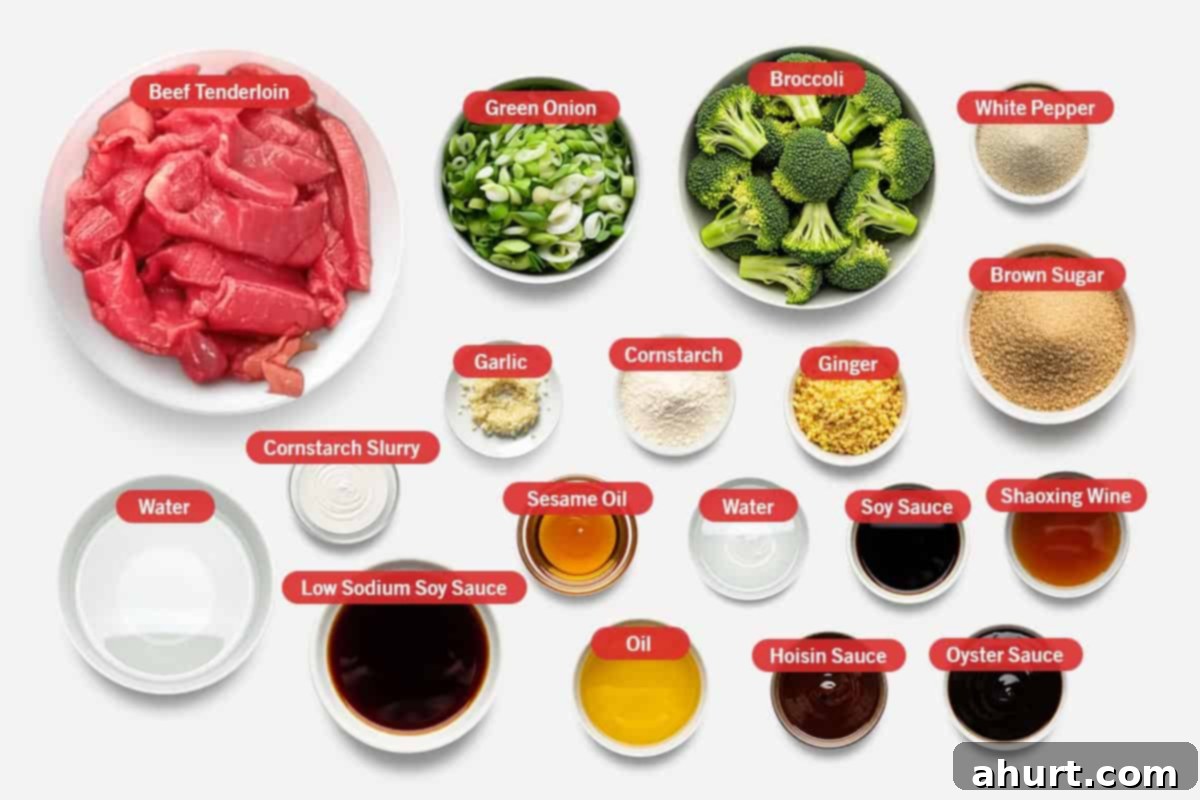
Crafting a truly exceptional Mongolian Beef and Broccoli at home means starting with quality ingredients that work together to create that signature sweet and savory profile. This recipe expertly combines simple pantry staples with fresh produce to deliver a flavor experience that genuinely surpasses most restaurant takeout. Here’s a closer look at the key components:
The Star: Tender Beef
- Beef Tenderloin: Opting for beef tenderloin is key to achieving that luxurious, melt-in-your-mouth texture. When thinly sliced against the grain, it cooks quickly and evenly, ensuring each piece is incredibly tender and absorbs the marinade beautifully. While tenderloin is recommended for its premium texture, other cuts like flank steak or sirloin can also be used, provided they are sliced thinly and marinated properly.
- Shaoxing Wine: This traditional Chinese cooking wine is an indispensable ingredient in Asian cuisine. It’s used in the marinade to add a profound depth of flavor and help tenderize the beef, contributing to a more authentic and complex taste profile. If unavailable, dry sherry or even a high-quality rice wine vinegar can be used as a substitute, though the flavor will be slightly different.
- Cornstarch: A vital component of the beef marinade, cornstarch is responsible for the “velveting” technique. It creates a protective coating on the beef, preventing it from drying out during cooking and ensuring it remains incredibly tender and silky smooth.
The Flavor Foundation: Rich & Glossy Sauce
- Low Sodium Soy Sauce: This forms the savory backbone of the sauce. Using a low sodium variety allows you to control the saltiness, ensuring the sauce is perfectly balanced without being overpowering.
- Brown Sugar (or Coconut Sugar): Essential for the characteristic sweet notes of Mongolian Beef, brown sugar adds a deep, molasses-like sweetness that caramelizes beautifully when cooked. Coconut sugar offers a slightly healthier alternative with a similar depth.
- Hoisin Sauce: While optional, hoisin sauce is highly recommended for an extra layer of sweet, tangy, and savory complexity. It adds a rich umami dimension that truly elevates the sauce to restaurant-quality.
- Oyster Sauce: Another fantastic addition for depth, oyster sauce provides a subtle sweetness and a rich, savory umami punch that enhances the overall flavor profile of the sauce.
- Ground White Pepper (or Red Chili Powder): White pepper offers a milder, earthy spice, while red chili powder can be used if you prefer a spicier kick, adding warmth and a subtle heat to the dish.
The Freshness Factor: Crisp Vegetables & Aromatics
- Broccoli Florets: Fresh broccoli is paramount for this dish. Its slight bitterness and crisp texture provide a wonderful contrast to the rich, sweet beef and sauce. It also adds a burst of vibrant green color and essential nutrients. Ensure florets are cut into manageable, bite-sized pieces for even cooking.
- Garlic & Ginger: These aromatic powerhouses are the soul of any good stir-fry. Freshly minced garlic and ginger infuse the oil with their pungent, fragrant flavors, building the foundation for the sauce. Don’t skimp on these for the best results!
- Green Onions (Scallions): Used both in the cooking process and as a garnish, green onions add a mild, oniony freshness that brightens the entire dish.
By bringing these carefully selected ingredients together, you’re not just making a meal; you’re creating a truly memorable culinary experience that’s both comforting and exciting.
Note: For a precise, full list of ingredients with exact measurements, please refer to the recipe card at the bottom of this page.
How To Master This Mongolian Beef And Broccoli Stir-Fry
Creating this flavorful Mongolian Beef and Broccoli is a straightforward process, but following these steps carefully will ensure a perfectly tender beef and a rich, glossy sauce every time.
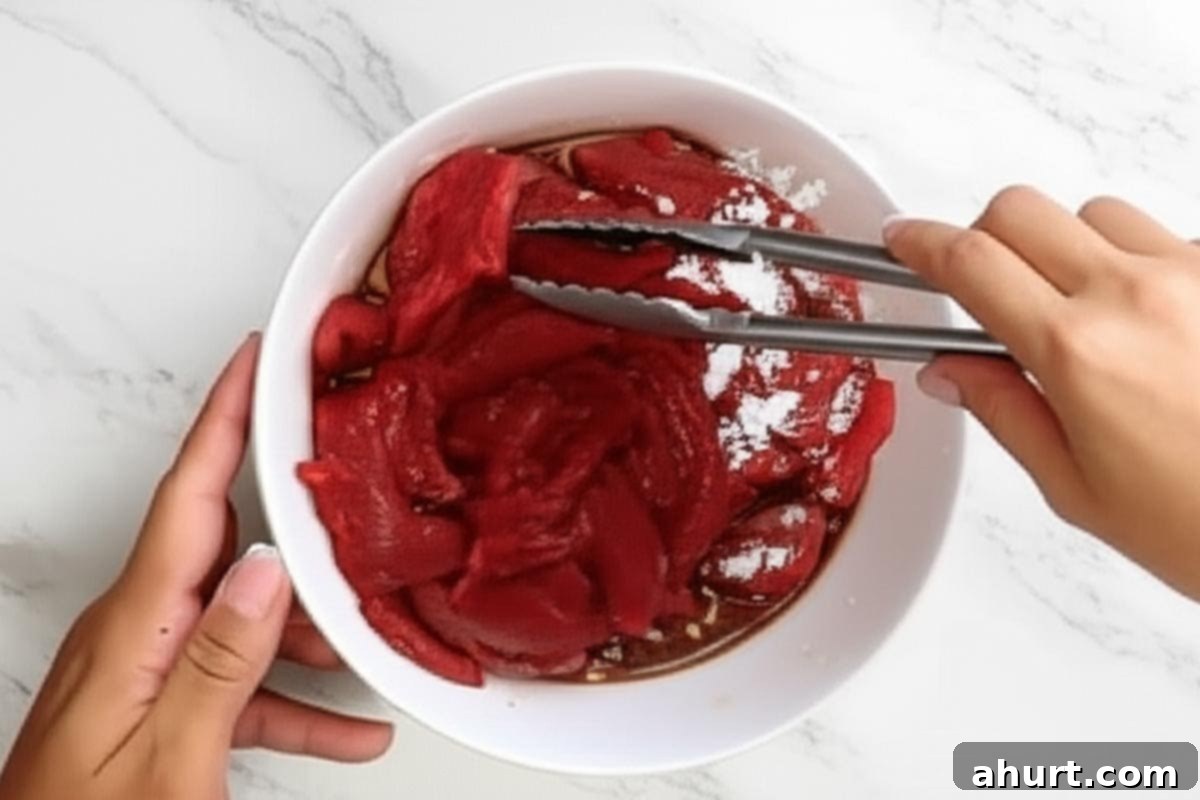
- Marinate the Beef for Tenderness: In a medium bowl, whisk together the marinade ingredients (water, soy sauce, Shaoxing wine, and cornstarch) until you have a smooth, well-combined mixture. Add your thinly sliced beef, ensuring each piece is thoroughly coated. Allow the beef to marinate for a minimum of 30 minutes, or up to 1 hour in the refrigerator. This “velveting” step is crucial for achieving incredibly tender beef.
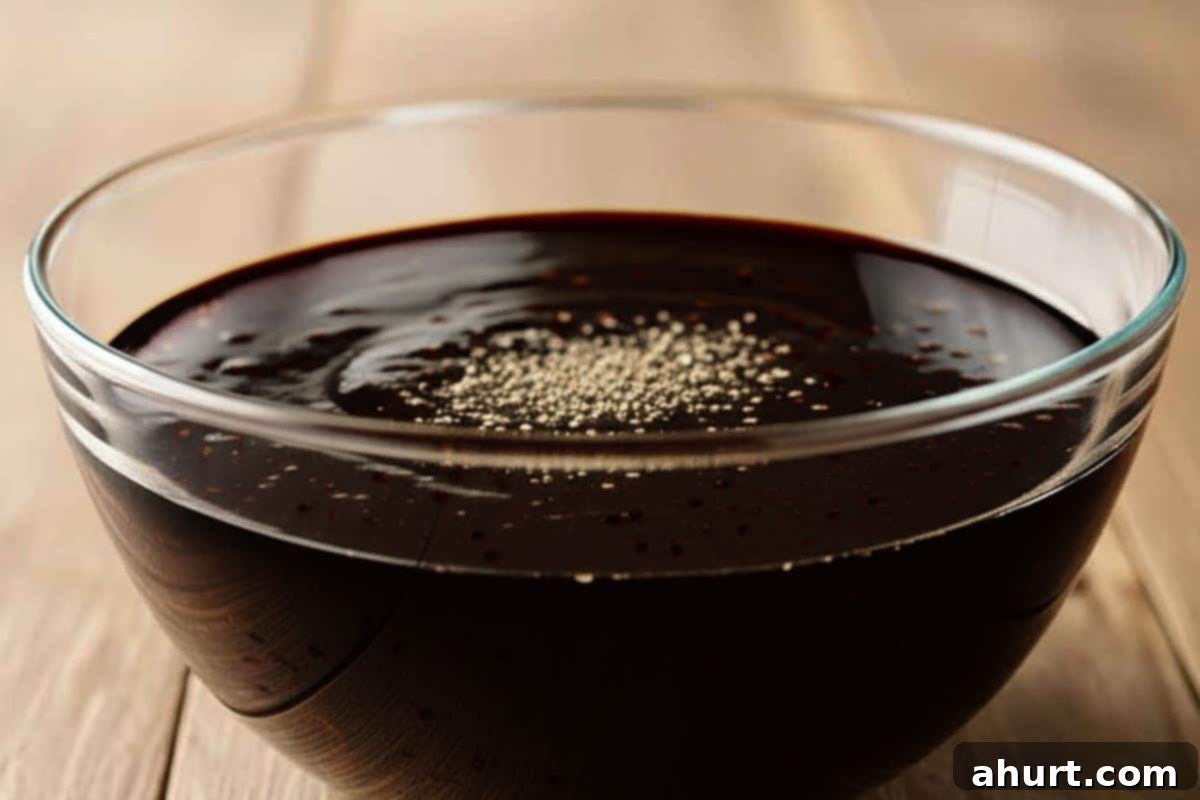
- Prepare the Signature Sauce: While the beef is marinating, combine all your sauce ingredients—low sodium soy sauce, water, brown sugar, hoisin sauce (if using), oyster sauce, and white pepper—in a separate bowl. Whisk thoroughly until everything is well combined and the sugar has dissolved. Set this flavorful mixture aside. This is also a great time to prep your vegetables (mince garlic and ginger, cut broccoli into florets, slice green onions) so they are ready to go for the stir-fry.
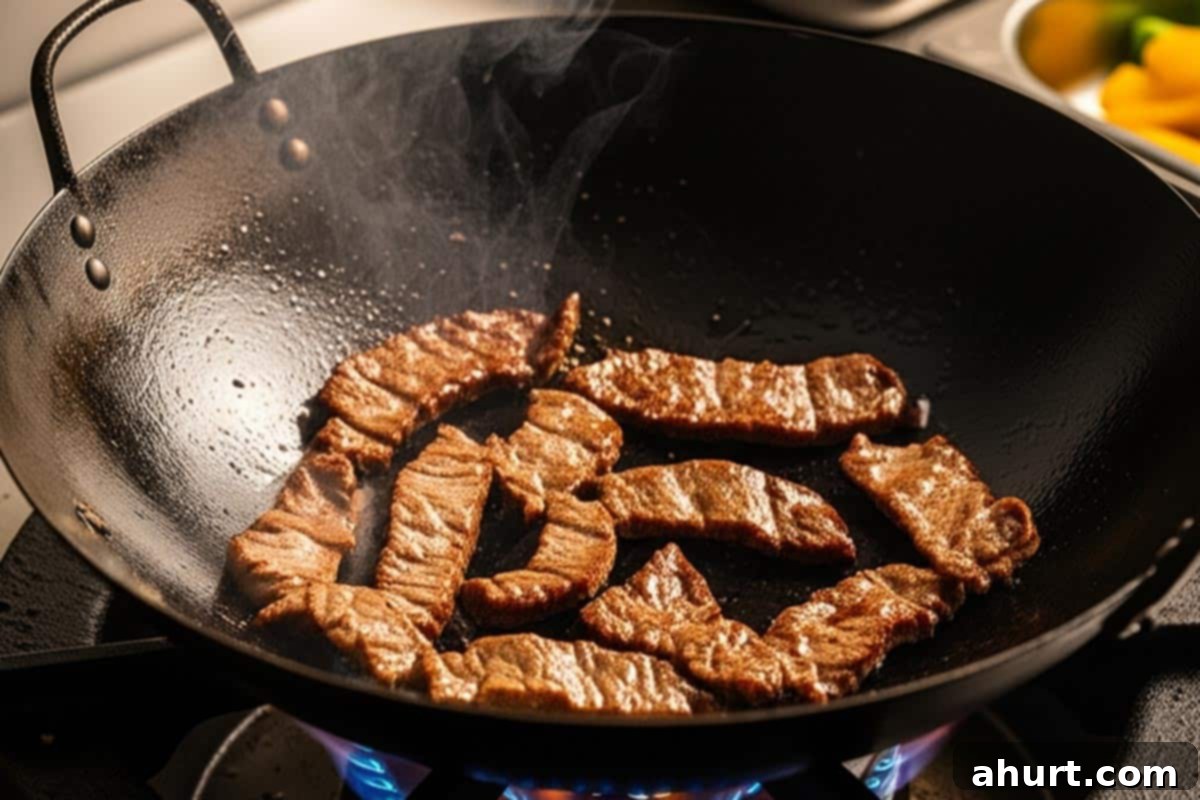
- Sear the Beef to Perfection: Heat 1/4 cup of cooking oil in a large wok or a wide, heavy-bottomed skillet over medium-high heat. Once the oil is shimmering, add the marinated beef in small batches, ensuring you don’t overcrowd the pan. Cook each batch for about 2 minutes, stirring occasionally, until the edges are just slightly crisp and golden brown. Overcrowding can lower the pan temperature and steam the beef instead of searing it, making it tough. Remove the cooked beef to a plate and set aside, leaving any remaining oil in the wok.

- Infuse with Aromatics: Reduce the heat slightly to medium. Add the teaspoon of sesame oil to the remaining oil in the wok. Immediately add the minced garlic and ginger. Stir-fry constantly for about 30 seconds, or until they become wonderfully fragrant. Be careful not to burn them, as this can lead to a bitter taste. This quick step is crucial for building a flavorful base.

- Cook the Vegetables to Crisp-Tender: Add the broccoli florets to the wok. Stir-fry for 2 to 3 minutes, or until they turn a bright, vibrant green and are just tender-crisp. You want them to retain a slight bite, so avoid overcooking. If you prefer your broccoli softer, you can blanch it briefly before adding it to the wok.

- Combine Beef and Sauce: Return the seared beef slices to the wok with the broccoli. Give your prepared sauce a quick whisk once more (as ingredients can settle) and pour it evenly over the beef and broccoli. Stir everything well to ensure all components are coated in the rich sauce. Let it simmer gently for about 2 minutes, allowing the flavors to meld and deepen.
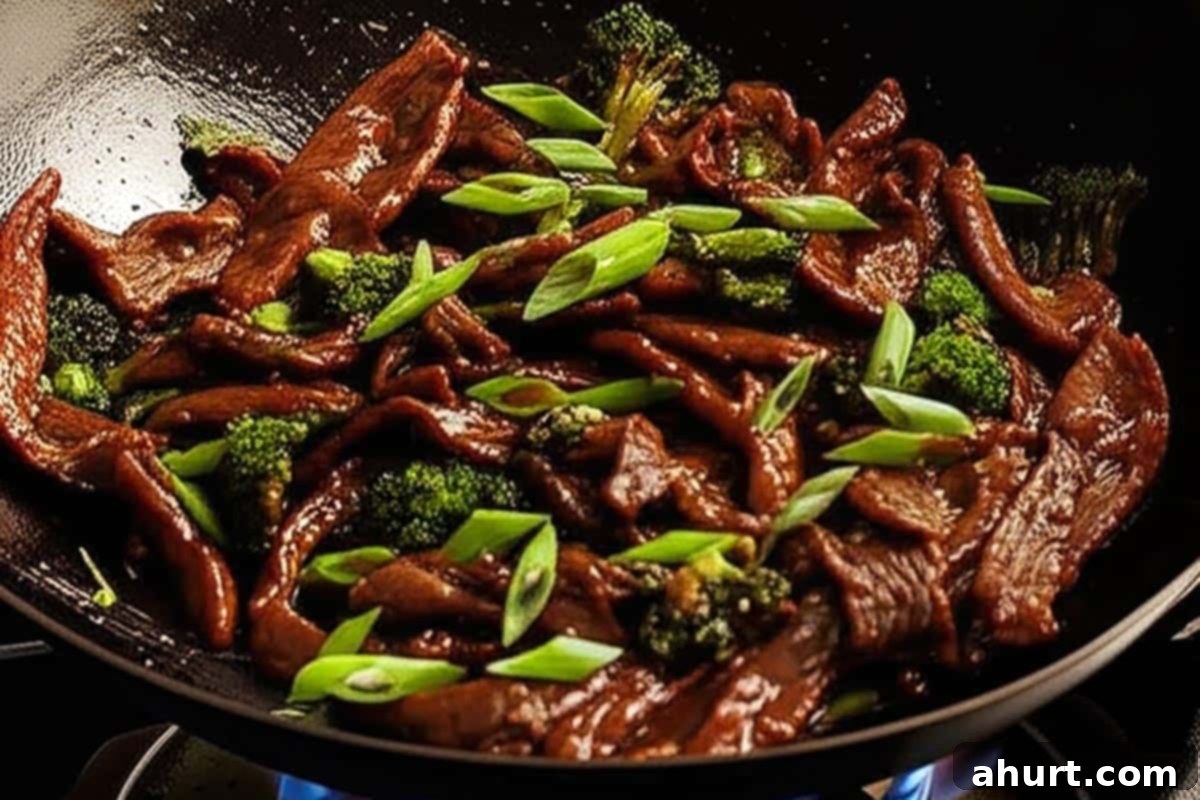
- Thicken the Sauce and Finish: Create a cornstarch slurry by mixing 1 tablespoon of cornstarch with 2 tablespoons of cold water until smooth. Pour this slurry into the simmering sauce in the wok, stirring constantly. Add the sliced green onions simultaneously. Continue cooking for another minute, stirring continuously, until the sauce thickens to your desired consistency—it should become beautifully glossy and coat the back of a spoon. Ensure everything is evenly covered in the now-thickened, flavorful sauce.

- Serve and Garnish: Turn off the heat. Transfer your piping hot Mongolian Beef and Broccoli to serving bowls. Garnish generously with extra sliced green onions for a final touch of freshness and color. Serve immediately over your choice of side—steamed white or brown rice, lo mein noodles, or even cauliflower rice for a low-carb option. Enjoy this incredibly satisfying, homemade dish while it’s hot and the sauce is perfectly glossy!
This saucy Mongolian Beef and Broccoli is incredibly versatile and pairs beautifully with a variety of sides to create a complete and satisfying meal. For a refreshing and vibrant contrast to the rich, savory beef, consider serving it alongside a crisp green salad or a Shrimp Guacamole Salad. The cool, creamy avocado and zesty shrimp offer a delightful counterpoint.
If you’re seeking something heartier and more comforting, a side of fluffy jasmine rice or a savory noodle dish works perfectly to soak up all that extra sauce. For a unique and indulgent twist, you could even explore pairing it with a rich dish like Sausage Eggplant Lasagna with Ricotta Pesto, creating an exciting fusion experience. Alternatively, for a lighter, low-carb option that still delivers on flavor, Creamy Sun Dried Tomato Chicken Zoodles make an excellent match. Each of these suggested pairings introduces its own unique textures and flavors, ensuring your Mongolian Beef and Broccoli meal is always a delightful culinary adventure.
Recipe FAQs & Essential Tips for Mongolian Beef and Broccoli
Absolutely, and we highly recommend it! This recipe is specifically designed to achieve wonderfully golden and crispy beef edges with just 1/4 cup of oil for two pounds of meat. This amount is more than sufficient to properly sear the beef, giving it that desirable texture without the heaviness, extra calories, or messy cleanup associated with traditional deep-frying. It’s a healthier and equally delicious alternative.
For successful stir-frying, the oil should be hot, but not excessively so. Medium heat is generally best. It’s hot enough to quickly sear the beef and create those delicious crispy edges without burning the meat or causing oil to violently spit and splatter across your stovetop. Aim for about 2 minutes per batch of beef to achieve perfect browning and tenderness.
The incredible tenderness of the beef in this recipe comes from a classic Chinese cooking technique called velveting. This involves marinating the thinly sliced beef in a special mixture, typically including cornstarch, soy sauce, and Shaoxing wine. The cornstarch forms a protective barrier around the meat, locking in moisture and ensuring it cooks up incredibly soft and succulent, mimicking the restaurant-quality texture you love.
While best enjoyed fresh, you can definitely do some prep work in advance. The beef can be marinated up to 24 hours ahead of time. You can also whisk together the sauce ingredients and chop your vegetables (garlic, ginger, broccoli) a day or two in advance. Store everything separately in airtight containers in the refrigerator. When it’s time to cook, the stir-fry comes together quickly!
Store any leftover Mongolian Beef and Broccoli in an airtight container in the refrigerator for up to 3-4 days. To reheat, gently warm it in a skillet over medium heat on the stovetop until heated through, adding a splash of water or broth if the sauce seems too thick. You can also microwave it, but the stovetop method often yields better texture for the beef and broccoli.

WATCH US MAKE MONGOLIAN BEEF RIGHT HERE

Saved
Pin
Mongolian Beef And Broccoli
Karina
10
minutes
36
minutes
46
minutes
6
Ingredients
Marinade:
-
2
lbs
beef tenderloin
thinly sliced against the grain -
2
tablespoons
water -
1
tablespoon
soy sauce -
1
tablespoon
Shaoxing Chinese wine -
2
tablespoons
cornstarch
(corn flour)
Sauce:
-
1/2
cup
low sodium soy sauce
(recommended for best flavor balance) -
2/3
cup
water -
1/3
cup
brown sugar
or coconut sugar -
2
tablespoons
hoisin sauce
(optional, but adds incredible depth of flavor) -
1
tablespoon
oyster sauce -
3/4
tablespoon
ground white pepper
or 1-2 teaspoons red chili powder for heat
Stir Fry:
-
1/4
cup
neutral oil
(e.g., vegetable, canola, grapeseed) -
1
teaspoon
sesame oil -
8
cloves
garlic
or 4 tablespoons, minced -
1/2
tablespoon
fresh ginger
minced -
1
head broccoli
cut into bite-sized florets -
4
green onion
scallion stems, thinly sliced (plus extra for garnish) -
1
tablespoon
cornstarch
(corn flour) mixed with 2 tablespoons cold water (cornstarch slurry)
Instructions
-
Whisk all marinade ingredients (water, soy sauce, Shaoxing wine, cornstarch) together in a bowl until smooth. Add the thinly sliced beef and toss to coat thoroughly. Marinate for 30 minutes to 1 hour (the longer the marinade, the more tender the beef will be).
-
While the beef is marinating, prepare the sauce. In a separate bowl, whisk together all sauce ingredients (low sodium soy sauce, water, brown sugar, hoisin sauce, oyster sauce, white pepper) until well combined. Set aside. Take this time to also prepare your vegetables: mince garlic and ginger, cut broccoli into florets, and slice green onions.
-
Heat a large wok or skillet over medium-high heat and add 1/4 cup of neutral oil. Once the oil is hot and shimmering, stir-fry the marinated beef in small batches (do not overcrowd the wok). Cook each batch for about 2 minutes, until just crisp on the edges and lightly browned. The beef cooks very quickly in hot oil, so avoid high heat to prevent splattering. Remove cooked beef to a plate and set aside, leaving any remaining oil in the wok.
-
Reduce heat to medium. Add the sesame oil to the wok with any remaining cooking oil. Add the minced garlic and ginger and stir-fry for about 30 seconds, until fragrant. Be careful not to burn the aromatics.
-
Add the broccoli florets to the wok and stir-fry for 2-3 minutes, until they are vibrant green and crisp-tender. Now, return the cooked beef back into the wok. Pour in the prepared sauce mixture. Stir well to coat all ingredients and let it simmer for about 2 minutes to allow the flavors to combine.
-
Give the cornstarch slurry a quick whisk and then stir it into the simmering sauce, along with the sliced green onions. Continue to cook for another minute, stirring constantly, until the sauce thickens to a beautiful, glossy consistency and coats the beef and broccoli. Turn off the heat.
-
Garnish generously with extra fresh green onion slices and serve immediately. This dish is best enjoyed hot over steamed rice, noodles, or additional steamed vegetables.
Notes
*If Shaoxing wine is unavailable, a good substitute would be dry sherry, or even a rice wine vinegar (though the flavor profile will be slightly different). Avoid regular white vinegar as it is too acidic.
Nutrition
Calories:
641
kcal
|
Carbohydrates:
29
g
|
Protein:
33
g
|
Fat:
44
g
|
Saturated Fat:
14
g
|
Polyunsaturated Fat:
4
g
|
Monounsaturated Fat:
20
g
|
Trans Fat:
0.04
g
|
Cholesterol:
106
mg
|
Sodium:
1216
mg
|
Potassium:
927
mg
|
Fiber:
4
g
|
Sugar:
15
g
|
Vitamin A:
712
IU
|
Vitamin C:
93
mg
|
Calcium:
95
mg
|
Iron:
5
mg
Nutrition information is automatically calculated, so should only be used as an approximation.
Tried this? Leave a comment below!
